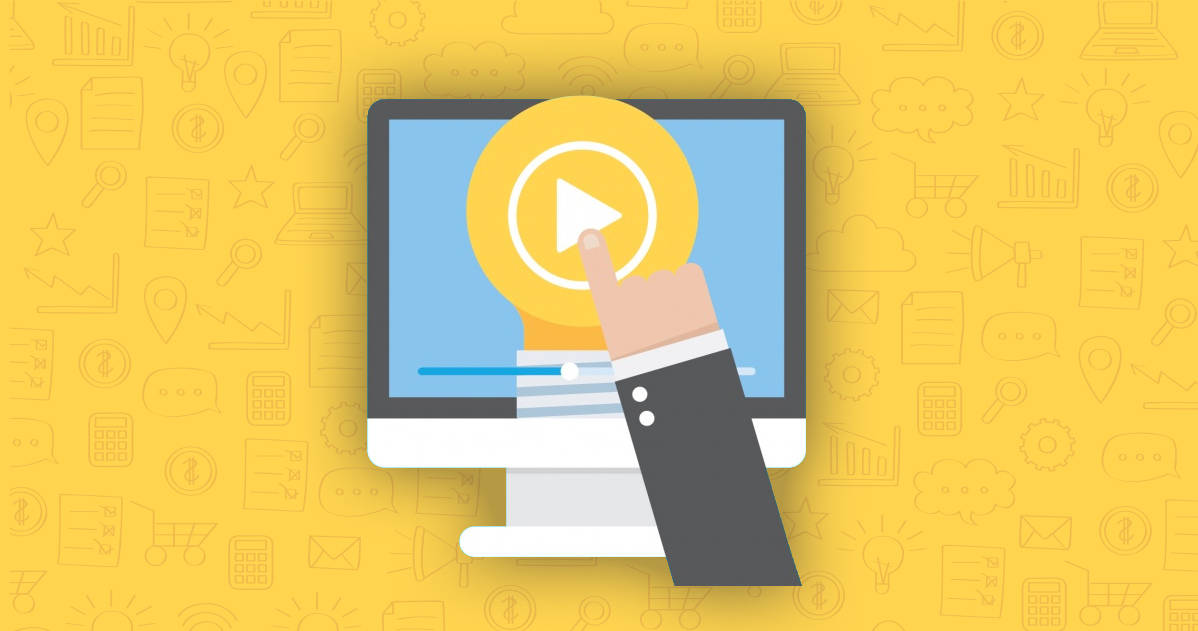Have you ever stopped to think about where your relationship with your customers ends? If you haven’t that’s fine because it’s kind of a trick question! When you stop and consider the complete customer journey, it becomes obvious that your brand is constantly in contact with each of your customers at every stage of their journey. From their initial site visit through to the final purchase (and beyond), you’re in a dialogue with your customers that creates a reputation for your store and your overall customer experience.
So why, then, do so many brands stop the conversation once the “purchase” button has been pushed? Yes, it’s common knowledge that customers become increasingly more likely to buy from you again the more they shop with you, but that doesn’t mean you can just ignore them! While you might think you no longer need to market to customers once they’ve made the first purchase, the truth is that to turn these shoppers into repeat purchasers, you’re going to need to give them a little TLC.
You can create a sense of delight that strengthens the relationship shoppers have with your brand with effective and intentional post-sale content With engaging, relevant content, you can build a successful retention strategy that keeps customers happy and brings them back to your store.
Here are five ways that you can use content to keep the lovelight burning between your store and your customers post-sale.
[click_to_tweet tweet=”5 Ways to Use Content to Engage Customers Post-Sale” quote=”5 Ways to Use Content to Engage Customers Post-Sale”]
Best Ways to Use Content to Engage Customers Post-Sale
1. Engage Your Customers By Saying Thank You
This first example is an obvious one, but important nonetheless. There’s a reason your parents teach you to say “please” and “thank you” – not only is it polite, but it’s also a great way to show your respect and appreciation for the actions another individual has performed.
The truth is, your parents’ advice is just as relevant today as it was back then. While ecommerce is all about optimization and automation, at the end of the day building customer relationships comes down to connecting with people. Politeness is one of the most effective ways to do just that and as a result, a sincere thank you is a key part of establishing not only trust but also a desire to return to a personable shopping experience.
This email from Abercombie & Fitch is an excellent example of how to create winning post-sale thank you emails. In this example, they’ve kept it simple and focused on the message they wanted to convey: they appreciate and value their customer’s business. This simple messaging makes it clear that they value the customer and want to build a relationship with them over time, no matter how many times they’ve already purchased.

Marks & Spencer takes a slightly different approach with follow up emails that emphasize feedback. By asking shoppers to review their recent purchases, they’re extending an opportunity to stay engaged past the point of sale, once again establishing the desire to cultivate a lasting relationship over time.
From these examples, you can see that follow up thank you emails are the perfect way to demonstrate your brand values to your customers in a friendly, approachable, and tangible way. With opportunities to promote customer service and overall experience, it’s no wonder that thank you emails result in a 10.34% conversion rate! This type of post-sale content will help bridge the gap between the time of order and time of delivery – an “awkward silence” where you can now add value that keeps your brand top of mind for each successive purchase.
2. Get Your Customers Started With a Guide
Have you ever bought a product that you’re super excited about but a little intimidated by? I know that’s how I felt after buying my first MacBook. After being a PC customer for so long, I wasn’t sure where to start with my new Mac and found myself looking for a guide to help get me up and running.
Although your products might come with instructions, you can improve and facilitate your customer’s learning curve by sending them a “how to” or “getting started” guide right to their inbox. Whether it’s an explanation of how to set the product up or tips and tricks on how to use it, this type of content is a fantastic way to help shoppers get started faster, making your products more valuable from the very first use.
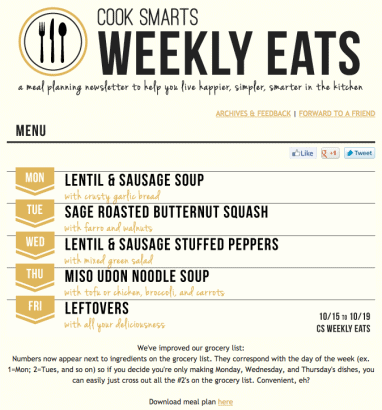
One of my favorite examples of this strategy is from Cook Smarts. As a subscription-based meal planning service, Cook Smarts understands that a lot of their customers are new to the world of cooking and meal prep. To help get them setup, customers are sent weekly meal plans and grocery shopping lists to make sure their kitchen is always stocked with the ingredients they need to make all of the delicious meals included in their subscription.
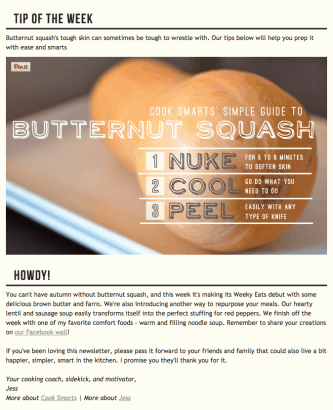
They don’t stop there, though! Each email also includes a tip of the week, where Cook Smarts’ experts explain how to improve a basic kitchen skill that can help any novice chef feel like a pro in no time.
While these content offerings might seem frivolous, they make all the difference to your brand’s post-sale experience. Sharing your product knowledge with your customers ensures that your products are providing additional value immediately. After all, why tell a customer how great your products are when you can just show them?
3. Ask for a Review to Keep Customers Engaged
Although we’ve already touched on this form of post-sale engagement, it’s worth taking a closer look at how to do it effectively. When a customer finally purchases your product, asking them for their opinion can help you generate valuable user-generated content that helps improve your brand’s reputation. 79% of customers trust a customer review as much as a personal referral, so collecting those reviews can have a significant impact on your bottom line.
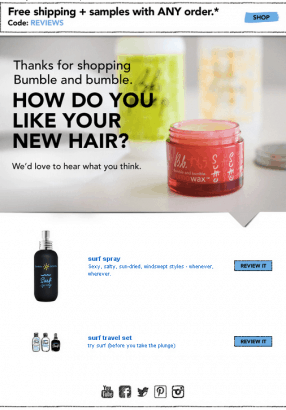
As you can see in this email from Bumble and bumble, asking for reviews is a key part of their post-sale content process. With large text at the top of the message, they make it clear that customer feedback is important and valued within their business and provide “Review It” buttons to make it easy for customers to share their thoughts.
With the valuable information provided by existing customers, potential buyers get a better idea of what they can expect when they engage with your products. This reciprocal relationship helps customers feel more invested with your customer experience at every step in the process and solidifies their positive associations with your brand. When sharing your opinion is this easy, who wouldn’t want to do it?
4. Show Customers Their Next Great Purchase with Upsells and Cross Sells
The fourth and final form of post-sale content we’re going to look at is upsells and cross-sells. Typically, these selling opportunities are presented as product recommendations, with the end goal being a repeat purchase from previously engaged customers.
While there are a number of ways you can do this, I’m going to give you 2 examples here.

As a fashion brand, J. Crew understands that customers will often browse multiple products before purchasing. They also understand the power of a second look, and as a result, invites their customers to reconsider items they might have overlooked the first time around. In this example, they combine the power of social proof with items the customer has already expressed interest in, using the review as an incentive to place each of these products in their shopping cart. J. Crew also includes a number of items that could be put together in an outfit, helping the customer envision a complete picture that keeps them well-dressed from head to toe.
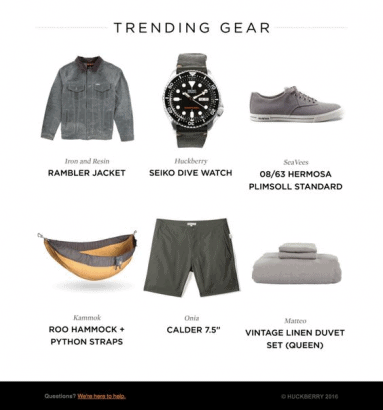
This second example from Huckberry is a little bit different. Instead of playing upon the specific customer’s interests, they use the word “trending” to indicate a greater interest from their whole range of customers. This associates the products they’re showing with a sense of consensus which will push customers towards the purchase button in an effort to belong.
In both cases, the upsells and cross-sells build upon the relationship each brand has already established with its customers. By adding additional value to the purchases customers have already made, they’re able to keep customers engaged and increase the likelihood they’ll come back to purchase again.
5. Invite them to a Customer Loyalty Program
Another excellent way to show your customers your appreciation and further engage them to post their purchase would be customer loyalty programs. This method is usually more popular between small businesses that have punch cards bringing the customers back in order to earn rewards.
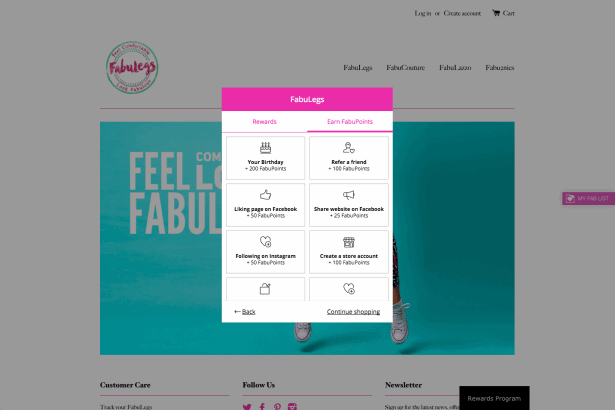
However, these loyalty programs also tend to work great for eCommerce stores as they have access to customer data that is rich and efficient.
Offer them with welcome points, brand your loyalty program more beautifully, include a call-to-action button on your home page, make the first reward easy to earn, make these rewards real appealing, also you can run a bonus point event—and voila you have an awesome and engaging customer loyalty program that keeps your customers interacting with your brand .
The real success of a loyalty program totally depends on how it pleases a brand’s customers in the longer-run. Since the goal of each loyalty program, besides showing their appreciation to customers is that to retain these customers, brands should provide a variety of ways to keep them engaged with the brand—using the any different channels people are active on.
Further, no matter what channel you’re on, don’t forget to continually surprise your customers with relevant rewards. Delight them and strengthen the connection between you and your customers.
Using Content to Build Relationships Post-Sale
With four actionable strategies and numerous branded examples, it’s clear that content is your most powerful tool when it comes to building post-sale customer relationships. With thank you messages, tips and tricks call for reviews, and recommendations, you have a number of different ways to continue developing profitable relationships with your valuable customers.
Remember: your customer conversations don’t have to end at the point of purchase. In fact, for today’s best brands that’s just the beginning. When you take the time to invest in your post-sale customer relationships, you might be surprised how quickly they turn back into new sales!


